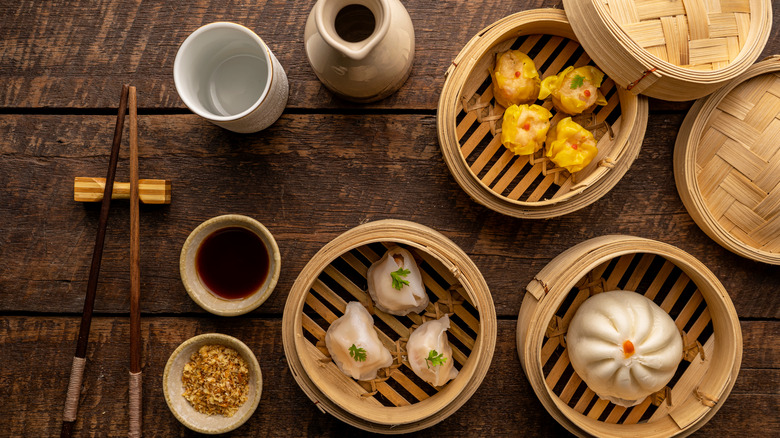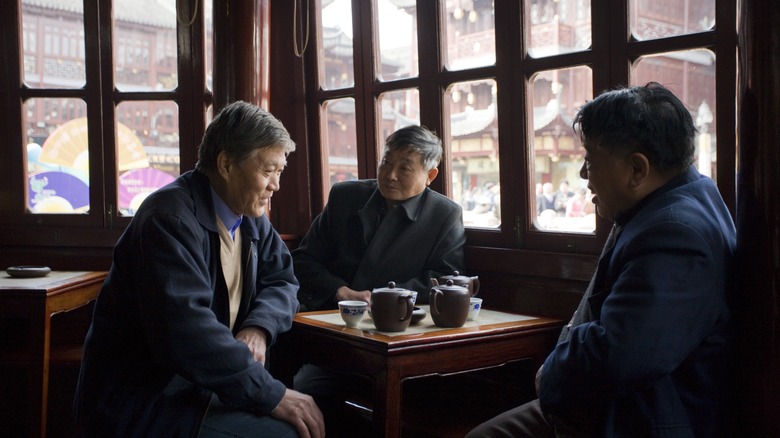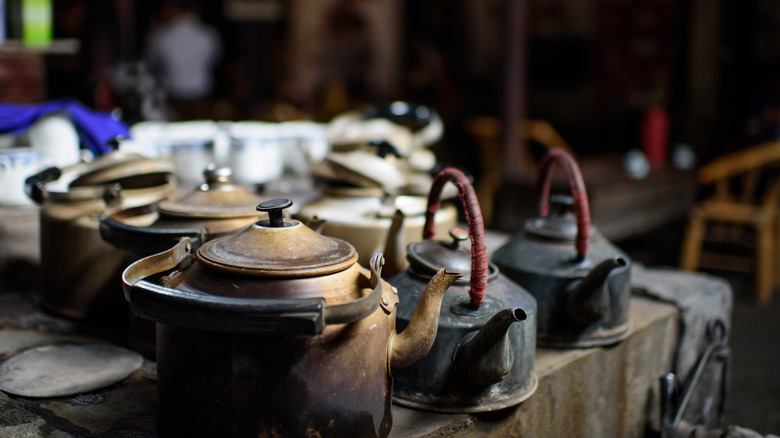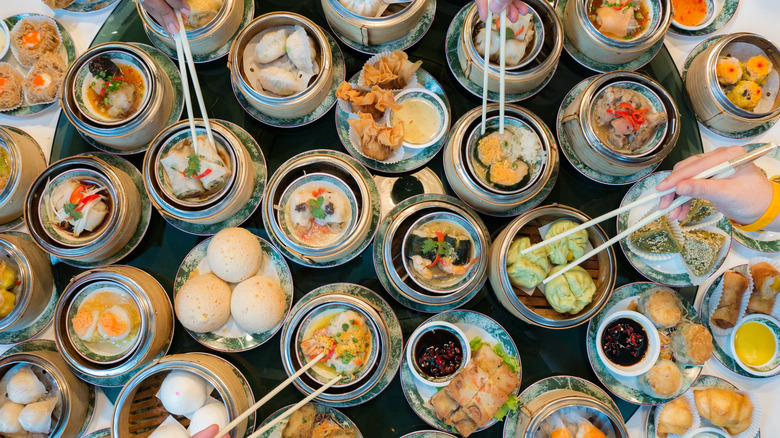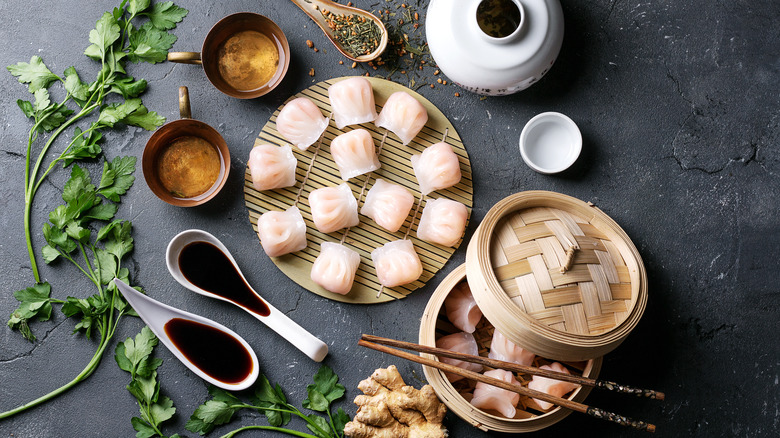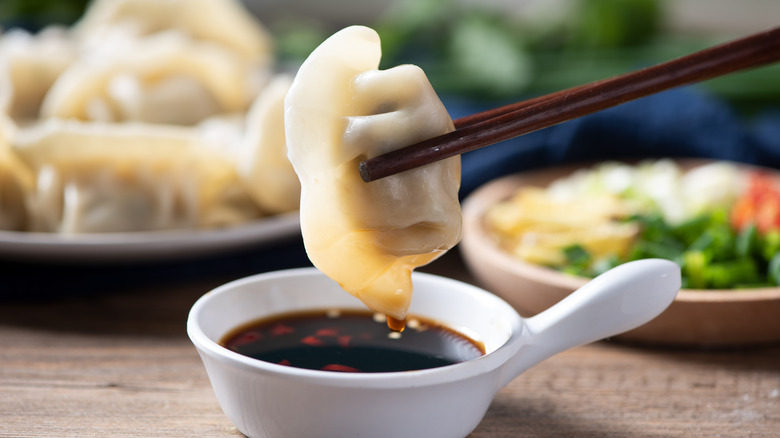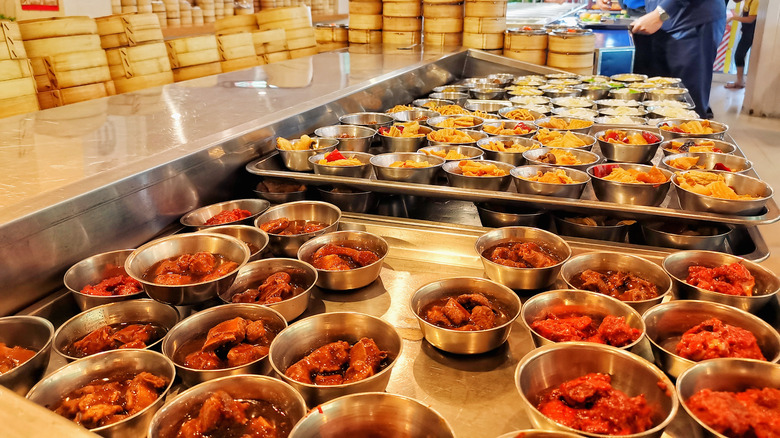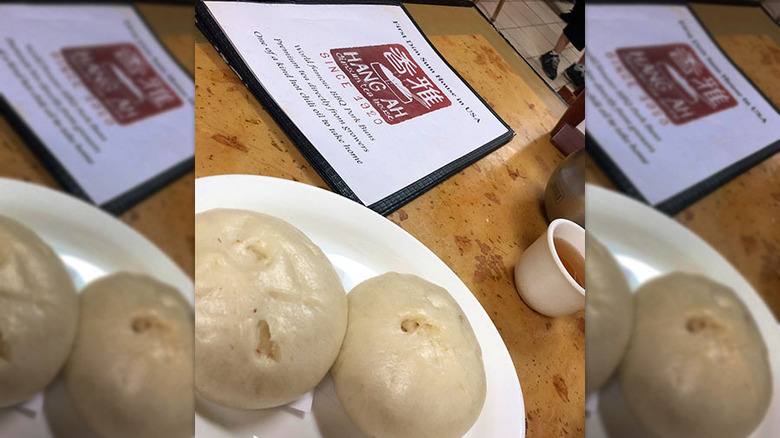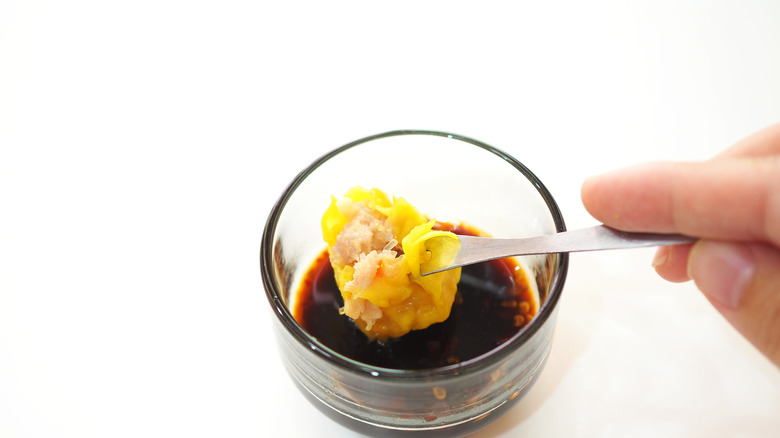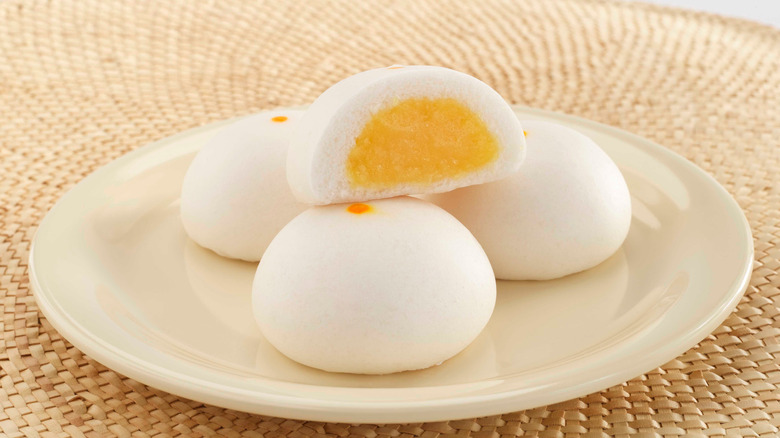The Untold Truth Of Dim Sum
Translating to "touch the heart" in Chinese, dim sum are bite-sized morsels stuffed with a variety of fillings composed of seafood, meat, and vegetables. Savory or sweet, the small bites take a variety of forms from dumplings and rolls to buns. Plus, they usually come steamed, fried, or baked. Typically served in bamboo baskets or on small plates, the small treats are a popular treat to share among family members and friends over leisurely meals.
Once served with tea for breakfast or brunch in ancient China, today dim sum is also frequently eaten in the evening. While the little parcels of goodness are still a staple of Chinese cuisine, dim sum has also made a name for itself in restaurants across the globe. And the uninitiated will be pleased to know that the modern ritual of eating dim sum is more straightforward than it may first appear. From prawn dumplings to pickled chicken feet, here are a few dim sum insights to get you on the right track.
Dim sum started out as a teahouse snack on the Silk Road
Most scholars agree that the culinary tradition of dim sum had its start along the Silk Road in China with the advent of teahouses thousands of years ago. Established to serve weary travelers making their way along the trade route, the teahouses would provide traders with a place to rest while indulging in a cup of tea. Since tea was believed to aid digestion, the small stalls soon started serving snacks — the predecessors of modern dim sum. According to the author of "The Dim Sum Field Guide," Carolyn Phillips, the birth of dim sum is also interconnected with the trade in flour since it's an essential ingredient in dough. "Chinese dim sum should probably start with discussions of the Silk Road because that is where wheat flour really made its way into China," she said (via My Recipes).
As time passed, the culinary art of dim sum gradually made its way to southern China. In fact, the dim sum tradition as we know it today in the West was invented in the southern Chinese province of Guangdong or Canton. Well-known for their varied cuisine — which includes chicken feet, offal, snails, and even snakes — the Cantonese are the masterminds behind many of today's dim sum dishes. According to Yauatcha, it's Cantonese cuisine that usually comes to mind when we think of Chinese food thanks to the large number of immigrants that arrived in the U.S. from Guangdong in the late 19th century (via FamilySearch).
Dim sum is traditionally served with tea
Dim sum is a part of the Chinese tradition of yum cha, or drinking tea, which originated with the Chinese tribes living along the border with India some two-thousand years ago. Centuries later, the yum cha tradition took off along the Silk Road where traveling traders took refuge in teahouses. The tea was soon paired with bite-sized snacks that would later become dim sum (via My Recipes).
In Chinese tradition, dim sum is served with a refillable pot of tea. Waiters are supposed to know when to refill the pot without interrupting the conversation of their patrons. One of the ways that diners can signal to a passing waiter that their teapot needs a refill is by resting the lid against the pot's handle. In traditional dim sum restaurants, patrons are usually given three main tea choices: pu'er (fermented black tea), jasmine tea, and chrysanthemum flower tea (via Epicurious).
Dim sum was originally served for breakfast and brunch
Once China's dim sum tradition arrived in Guangdong, it became a big part of the province's morning ritual with the little morsels typically served for breakfast and brunch. "You'd start the day with tea and some really filling, high-calorie snacks to get you going for the day and give you enough calories to get through your work. That basically meant strong tea and dumplings and any little cakes," said the author of 'The Food of China,' E.N. Anderson (via My Recipes).
Today, traditional dim sum restaurants in China open their doors around five in the morning and close in the early afternoon. And they don't reopen for dinner. This, of course, isn't the case with more modern establishments that offer the small plates all day and well into the evening (via Yauatcha). According to Made in my Kitchen, it's the tradition in China for the elderly to meet up for dim sum after their morning exercise. Sharing dim sum is also a common family ritual on Saturday and Sunday mornings.
There are hundreds of different dim sum varieties
From steamed and deep-fried to baked and roasted, dim sum come in a huge range of shapes and sizes. Since the number of dim sum out there can be overwhelming, it's probably best to classify them into easily recognizable categories such as dumplings, buns, and rolls. Some of the most popular dim sum in the dumplings category include har gau, or steamed shrimp dumplings, and siu mai, or steamed pork or shrimp dumplings with an open top. One of the favorites in the dim sum bun department are cha siu bao, or steamed barbecue pork buns. Meanwhile, rolled dishes include pei guen, or fried tofu skin rolls, and cheong fun, or rice noodle rolls (via Serious Eats).
A hit with both carnivores and vegetarians, dim sum can contain either meat, seafood, or vegetables. The main ingredients in dim sum include pork, chicken, beef, as well as prawns. While much less common than their meaty counterparts, dim sum cuisine also features vegetarian options. Some of the more common veggie dim sum choices include lo mai gai, or sticky rice with mushrooms and greens, and mapo tofu, or tofu in spicy sauce (via Bite).
Different types of dim sum are meant to be eaten with different sauces
However prepared, most dim sum aren't spicy. Instead, they are meant to be paired with a range of sauces. This gives diners the opportunity to customize the flavor of the small morsels to their exact specifications. Dim sum are often served with light soy sauce, the name of which refers to the condiment's color rather than flavor. Another very popular pairing for dim sum is XO sauce. Originating in Hong Kong, the sauce is made from chopped-up dried shrimp and scallops, as well as spices such as dried chili.
China abounds with dim sum sauce pairings that aren't commonly found in western restaurants. One of these is black rice vinegar. Similar to balsamic vinegar, the condiment is often paired with Shanghainese xiao long bao and jiaozi dumplings. Typically served with steamed rice noodle rolls, hoisin sauce is a sweet condiment made from soybeans and sugar. Last but not least, deep-fried dim sum are often matched with a tangy-sweet plum sauce.
Eating dim sum comes with its own etiquette
There are certain protocols associated with dining at a traditional dim sum restaurant, although most aren't commonly followed in modern establishments or restaurants outside China. Since dim sum are traditionally served with tea, refrain from asking your waiter for coffee (asking for water is acceptable). When the teapot arrives at the table, never fill your cup first. Instead, make sure that the cups of your dining companions are filled first (via Epicurious). When a member of your dining party pours you a cup of tea, tap the table in a gesture of gratitude. And how you express your thanks depends on your marital status — the singles tap the table with their index finger while those married tap the table with both their index and middle fingers (via Ocean Palace).
When it comes to eating dim sum, never leave your chopsticks sticking up from your food since in Chinese culture this is a sign of death and mourning. In addition, be sure to always transfer each dim sum piece to your own plate from the shared plate or bamboo basket before eating it (via GLP Worldwide).
Don't be shy to ask the waiter for sauces, and if the restaurant you are dining at has a cart system, feel free to chase one down as soon as it rolls out of the kitchen to get the freshest dim sum — just be sure to have your table's tally card on hand to have it stamped by the waiter.
The largest dim sum meal involved 764 diners
The largest dim sum meal ever took place in Sydney, Australia in February of 2019. The dining experience, which involved 764 participants, has been entered into the World Guinness Book of Records. The Sydney event beat a record set at a Melbourne restaurant Chan's Yum Cha in Australia in 2013 by hosting an additional 14 diners.
The 2019 record-breaking event was a part of the Sydney Lunar Festival held to ring in the Year of the Pig. The 3,100 pieces of dim sum were offered to the public free of charge by a dim sum food truck Let's Do Yum Cha (this means that each participant received at least four of the savory parcels). The menu included chicken, pork, and two different vegetarian dim sum options — all served with the obligatory soy sauce. To qualify, participants had to eat at least two different types of dim sum (via Guinness World Records).
America's oldest dim sum restaurant is in San Francisco
Hang Ah Dim Sum Tea House has been dishing out tea, noodles, and dim sum since the 1920s. Located at 1 Pagoda Place (we love this!) in San Francisco's Chinatown, an area that has managed to dodge the gentrification sweeping the nearby neighborhoods, the eatery is a cozy enclave for an afternoon snack or dinner. The restaurant got its name — Ah Dim — due to its location in an alleyway that once housed an incense manufacturer (ah translates to aroma in Chinese). Some of the standout offerings on the menu of this little gem include shrimp dumplings, pork meatballs, and spareribs in black bean sauce.
The historical hole-in-the-wall restaurant has changed hands numerous times since first opening its doors over a century ago. The current owners — Billy Lai and Frank Chui — took the restaurant over in 2014. And their mission has been to retain Hang Ah's unique character. "We love the place because it looks different than [what's] outside of Chinatown," Lai told Vice. "Our oldest customer, he's about a hundred, or something — he said the last time he came before his last visit was maybe about 30 years ago."
The most expensive dim sum ever sold cost $517
Priced at $517.03 a pop, the blue diamond dim sum comes infused with a range of rare and outlandishly-priced ingredients. Offered by the German organic food company Yumbau, the blue dumplings are made to order for those wealthy enough to purchase them through the company's website. Those not quite up for the challenge of spending hundreds of dollars on a mouthful of food can choose from the company's extensive range of other dim sum and dim sum sauces.
So what makes these small morsels worth so much cash? To start off with the filling is a concoction of saffron, truffle, caterpillar fungi, the boletus edulis mushroom, and blueberry powder. Perhaps the most important ingredient in the filling, black-boned chicken is a delicacy in China. The dumpling dough is rolled to just 0.4-inch thickness and shaped into circles. And the distinct blue hue is achieved with a dash of natural spirulina (via Guinness World Records).
Dim Sum can take the form of dessert
While desserts are probably not the first thing that comes to mind when thinking about dim sum, sweet bites form a huge part of the culinary tradition. And while we are all used to eating desserts as the last course of a meal, sweet dim sum can be eaten at any time during the proceedings — in other words, there's no set order when eating dim sum (via Epicurious).
One of the most popular dessert dim sum options is jin dui, or friend glutinous rice balls. The chewy treats typically feature a red bean or lotus paste filling and come coated in sesame seeds. Very similar to Portuguese pastéis de nata, daan taat are eggy custard tarts. Some other indulgent dim sum offerings bound to satisfy those with a sweet tooth include do fu fa, or silken tofu pudding served with syrup, and lai wong bao, or steamed buns stuffed with custard (via Serious Eats).
